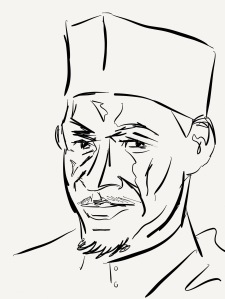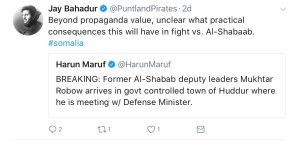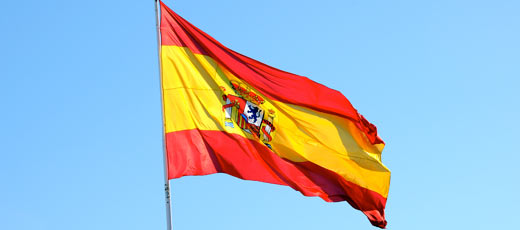
Robow speaks to the media at the City Palace Hotel in Mogadishu on Tuesday, swapping the black flag of al-Shabaab for the Somali national flag
ABU MANSOUR MOKHTAR ROBOW, former Deputy Emir of al-Shabaab, entered into discussions with the Federal Government of Somalia this week. In an information vacuum (where, bizarrely, the potential defector seemed to be taking the lead in explaining what was happening), there was much speculation about the significance and even the desirability of negotiating with someone like Robow.
Despite his ideological and military credentials, Robow had become a source of great aggravation to al-Shabaab after he split with the group’s leadership ‘over ideological differences’. For 6 years he inhabited a grey space between al-Shabaab and the Federal Government, a state of limbo where his clan-based personal militia afforded him enough protection to deter al-Shabaab from simply killing him but where, at the same time, his stern refusal to renounce either violence or a broader Nationalist Islamist agenda that transcends a mere organisation like al-Shabaab (an ideology that still receives much tacit support in Somali society) precludes amnesty. This makes his defection to the government challenging to say the least.
It is unclear what turned the uneasy stalemate between Robow and al-Shabaab into open hostilities, with al-Shabaab massing forces in Bakool and launching a series of unsuccessful assaults on Robow’s rural stronghold. Perhaps al-Shabaab received word of Robow’s negotiations with Southwest State and senior members of his clan (Rahanweyn) in the national parliament in Mogadishu. Or perhaps the time had come for someone to rid al-Shabaab of ‘this turbulent priest’. It is unlikely we will ever know since key players in Somalia’s insurgency seldom get to write their memoirs. What we do know is that the attack forced Robowe into the arms of the government, although 19 of Robow’s men didn’t get to join him.
Robow allowed himself to be moved to Mogadishu, his security guaranteed by no less than the Somali Minister of Defence himself (although Robow was, it is rumoured, initially resistant to the move to the capital). Once there he entered a process that some described as a negotiation, others as a debriefing. He spoke to the media at the City Palace Hotel (across the road from the Somali National Intelligence & Security Agency’s headquarters), reading a prepared statement and answering no questions – and, notably, not condemning violence, not rejecting the broader Nationalist Islamist ideology (just the manifestation of it that is al-Shabaab), nor confessing his crimes and seeking forgiveness.
One line of response focussed on the lack of a rejection of violence, the failure to address all those crimes. This wasn’t new: when Atom defected in 2014, there was a similar furore from those who had suffered when his localised dispute with the local government in Puntland merged with al-Shabaab’s parallel antipathy for the Puntland Authorities. But Atom, while deeply religious, was never an ideologue. If anything he was a criminal, a bandit, a gun-runner. It was a relief when he finally said the right things to the media and was re-located to a Gulf State for the rest of his days. When Aweys, who actually was an ideologue, defected, he was not perceived to have blood on his hands. But Robow is both: violent and ideological and, apparently, not yet reconciled.

Atom, 2014 sketch by Our Man on the Horn
For that reason many local commentators and even the worthies at Human Rights Watch, taking advantage of the unique view you get into Somalia from the raised balcony of a coffee shop in an affluent part of northern Nairobi, feel that there must be justice. But justice in Somalia involves a wooden post and some from-the-hip automatic fire. (Reconcile that.) As a Briton and a former British Army officer at that, I can’t help but note that we would still be fighting in Northern Ireland if we had stuck to that line of uncompromising, inflexible ‘justice’. But we aren’t because we found it in ourselves to forgive and to reconcile (however tentatively).

Other commentators conjectured that, while Robow was once a significant figure within al-Shabaab, he was now little more than a propaganda symbol since he had been isolated from the hard core of the group for so long.

And, as is so often the case when international commentators look at Somalia, a deep lack of understanding of how Somalia works is exhibited, coupled with an absence of imagination, a lack of vision as to how Somalia might eventually ‘work’ in the future. And that means ‘The C Word’.
Clan.
Robow is a Rahanweyn from the sub-clan Leysaan and the sub-sub-clan Orsi. al-Shabaab were well aware of the significance of this: that is why they sent the Shadow Governor of Galgaduud, Sheikh Hassan Yaqcub, to lead the assault on Robowe’s hideout in the hinterland, because he too was a Rahanweyn-Leysaan-Orsi. They were probably also very aware of the predominance of Rahanweyn in the organisation itself, with perhaps more than half of the organisation coming from the clan, at the foot-soldier level at least (although understanding of the demographics of al-Shabaab remains hazy even 11 years after the Ethiopian invasion).
And that is where the real significance of Robowe might lie. If Robow can find it in himself to put aside not just his violent, xenophobic, Nationalist-Islamist agenda, if he can commit to working with the government to rebuild Somali, but, most importantly, if he still has influence over his Rahanweyn clansmen, even a proportion of them, and if he can bring them out with him, then Robow might be the most important defector from al-Shabaab to date.




























